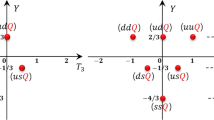Summary
The possibility that the existing strongly interacting particles correspond to the simplest self-consistent solution of a dispersion-theoretic bootstrap model is considered. A generalization of the Chew reciprocal bootstrap model is applied to baryons. Three simple self-consistency requirements are postulated. It is shown that the Hermitean property of the unreduced elastic crossing matrix favors a low spin value for the ground-state baryon multiplet. Attention is then limited toSU 3-invariant schemes of particles. The physical, octet-decuplet particle set, known from several previous works to satisfy similar models, is a solution to the present model. The hypotheses that the ground-state baryon multiplet corresponds to anSU 3 singlet, triplet, or sextet do not lead to a solution involving fewer particles than the octet-decuplet solution. TheF/D interaction angle in the octet-decuplet solution is 31.8°. There is a moderately strong attraction in theP 1/2 states of the representation 10* in this solution.
Riassunto
Si considera la possibilità che le esistenti particelle con interazione forte corrispondano a semplici soluzioni autocoerenti di un modello a bootstrap in teoria della dispersione. Si applica ai barioni una generalizzazione del modello di bootstrap reciproco di Chew. Si postulano tre semplici condizioni di autocoerenza. Si dimostra che la proprietà hermitiana della matrice di incrocio elastica non ridotta favorisce un basso valore dello spin per il multipletto barionico dello stato fondamentale. Si limita quindi l’attenzione a schemi di particelle invarianti nelleSU 3. Il gruppo di particelle dell’ottetto-decupletto fisico, di cui si sa da numerosi lavori precedenti che soddisfa modelli analoghi, è una soluzione del modello qui esposto. Le ipotesi che il multipletto barionico dello stato fondamentale corrisponda ad un singoletto, tripletto o sestetto nellaSU 3 non portano a soluzioni che interessano un numero minore di particelle della soluzione dell’ottetto-decupletto. L’angolo di interazioneF/D nella soluzione di ottettodecupletto è 31.8°. In questa soluzione si ha un’attrazione moderatamente forte negli statiP 1/2 della rappresentazione 10*.
Similar content being viewed by others
References
R. H. Capps:Phys. Rev.,134, B 460 (1964).
G. F. Chew:Phys. Rev. Lett.,9, 233 (1962).
In general it is the full crossing matrix (defined in Sect. IIIA of ref. (1)), rather than the elastic crossing matrix, that satisfies the conditionC 2=1. However, in all the examples considered in this paper except that of Sect.3 4,SU 3-invariance and angular-momentum conservation forbid inelastic processes in the (i, m) representation. In these cases the elastic and inelastic parts ofC are not connected, and the conditionC 2=1 applies separately to either part.
I. S. Gerstein andK. T. Mahanthappa:Nuovo Cimento,32, 1663 (1964).
A somewhat similar argument has been applied to the pion-pion scattering amplitudes of different isotopic spins byG. F. Chew:Proc. of the 1962 Annual International Conference on High-Energy Physics at CERN, edited byPrentki (CERN, Geneva, 1962), p. 525. It should be pointed out that the signs appropriate for different elements of a crossing matrix depend on the type of process being considered. For this reason, the crossing matrix considered byChew is not of the type defined in the present paper. The sum of the element of theI-spin 0 row of the crossing matrix considered byChew is greater than the corresponding sums for theI=1 andI=2 rows; this fact is important to the argument. On the other hand, the sum of the elements of any row of any of theC matrices used here is unity (see Sect. IIIA of ref. (1)).
The reduction of direct products of representations ofSU 3 is discussed in detail byR. E. Behrends, J. Dreitlein, C. Fronsdal andB. W. Lee:Rev. Mod. Phys.,34, 1 (1962). Our notation for the representations is essentially the same as that of this reference.
R. E. Cutkosky, J. Kalckar andP. Tarjanne:Phys. Lett.,1, 93 (1962). These authors consider the forces resulting from the exchange of the ground state triplet in the μB0 states formed from a baryon triplet and meson octet. However, they do not consider the forces resulting from exchange of the excited baryon states.
R. E. Cutkosky:Ann. Phys.,23, 415 (1963). The crossing matrix (Table II of this reference) is the transposition of the matrix defined in the present paper. The symbolQ refers to the inelastic amplitude 8s⇄8a.
A. W. Martin andK. C. Wali:Nuovo Cimento,31, 1324 (1964).
Yasuo Hara: preprint, March 1964.
The parameterf used in refs. (4), (10), and (11) is related toθ by the relation tgθ=(9/5)1/2 f/(1−f).
L. D. Roper:Phys. Rev. Lett.,12, 340 (1964).
The correction to the valueθ∼33° resulting from inclusion of the baryonoctet exchange force has been calculated independently (by slightly different methods than that used here) byK. C. Wali (private communication) and byY. Hara: ref. (11). The three results agree to within a degree. The author would like to thank Dr.Wali for communicating his results on this print.
A. W. Martin andK. C. Wali:Phys. Rev.,130, 2455 (1963)
SeeG. F. Chew andF. E. Low:Phys. Rev.,101, 1570 (1956) andJ. Ashkin, J. P. Blaser, F. Feiner andM. O. Stern:Phys. Rev.,101, 1149 (1956).
SeeG. F. Chew: ref. (6)G. F. Chew:.
Author information
Authors and Affiliations
Rights and permissions
About this article
Cite this article
Capps, R.H. SU 3-Invariant solutions to a reciprocal bootstrap model. Nuovo Cim 34, 932–945 (1964). https://doi.org/10.1007/BF02812522
Received:
Published:
Issue Date:
DOI: https://doi.org/10.1007/BF02812522



